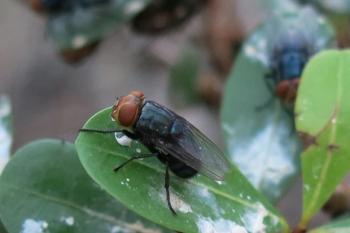
Purdue veterinary school performs groundbreaking kidney surgery
WEST LAFAYETTE, IND.-Purdue University veterinarians set precedent for diagnosis and treatment of a kidney tumor in a 23-year-old horse. Jan Hawkins, DVM, Dipl. ACVS, associate professor of large animal surgery, Purdue University, removed the horse's kidney through its flank using no general anesthesia. The right kidney was removed using a hand-assisted laparoscopic technique.
WEST LAFAYETTE, IND.—Purdue University veterinarians set precedent for diagnosis and treatment of a kidney tumor in a 23-year-old horse. Jan Hawkins, DVM, Dipl. ACVS, associate professor of large animal surgery, Purdue University, removed the horse's kidney through its flank using no general anesthesia. The right kidney was removed using a hand-assisted laparoscopic technique.
Laurent Couetil, DVM (far right) diagnosed the ailing Chico, a 23-year-old horse with a kidney tumor. Chico underwent surgery to remove a tumor at Purdue University and was the first-known success story on this specific surgery. Jan Hawkins, DVM, second from left, performed the procedure. Owner Frank Daskalos (far left) and Janet Daskalos rejoice in the successful surgery.
Chico's owners discovered a problem when they noticed blood in the animal's urine. The horse had become anemic by the time the surgery was performed, but a blood transfusion was not required. To determine the source of bleeding an endoscopic examination of the bladder was performed. This examination revealed that blood was coming exclusively from the right kidney. An external ultrasonographic examination of the right kidney was inconclusive in identifying the cause of bleeding. Despite this, a tumor involving the right kidney was suspected.
To confirm the diagnosis, a standing exploration of the abdomen was recommended to the owner. Through an eight-inch flank incision, the right kidney was palpated. No palpable abnormalities of the kidney were found. An internal ultrasound of the kidney was performed by Laurent Couetil, DVM, Dipl. ACVIM, associate professor of large animal internal medicine at Purdue University. Dr. Couetil diagnosed a tumor within the cortex of the kidney. The owners consented to removal of the kidney to resolve the source of bleeding.
The traditional method of kidney removal is via rib resection while under general anesthesia. Instead of using the technique, Hawkins used a hand-assisted laparoscopic technique. Prior to Chico's surgical procedure, the veterinarians practiced the surgery on a donated horse already scheduled for euthanasia. "The horse we practiced the procedure on had extra vessels to the kidney that caused some bleeding when it was dissected from the body," Hawkins says.
The horse's owners were concerned about putting the horse under anesthesia because of risks, such as post-surgical pneumonia and the possibility of a leg fracture during anesthetic recovery. The laparoscopic surgery eliminated the requirement for general anesthesia and rib resection. The surgical procedure performed on Chico proceeded with no complications, according to Hawkins.
"The horse walked back to its stall after the surgery," Hawkins says. "He was initially uncomfortable after the surgery, but it's amazing how much easier this procedure was on the horse, when compared to removal of the kidney via rib resection." Hawkins says the tumor is being analyzed to see if it is cancerous. If it is benign, then the horse shouldn't have any further problems associated with the tumor or surgery, he says.
Couetil says he has encountered similar cases before but was unable to help other animals because the tumors were too far advanced. "I think this has been an excellent learning experience, and I would feel comfortable using the same technique on another horse," he adds.
Newsletter
From exam room tips to practice management insights, get trusted veterinary news delivered straight to your inbox—subscribe to dvm360.






